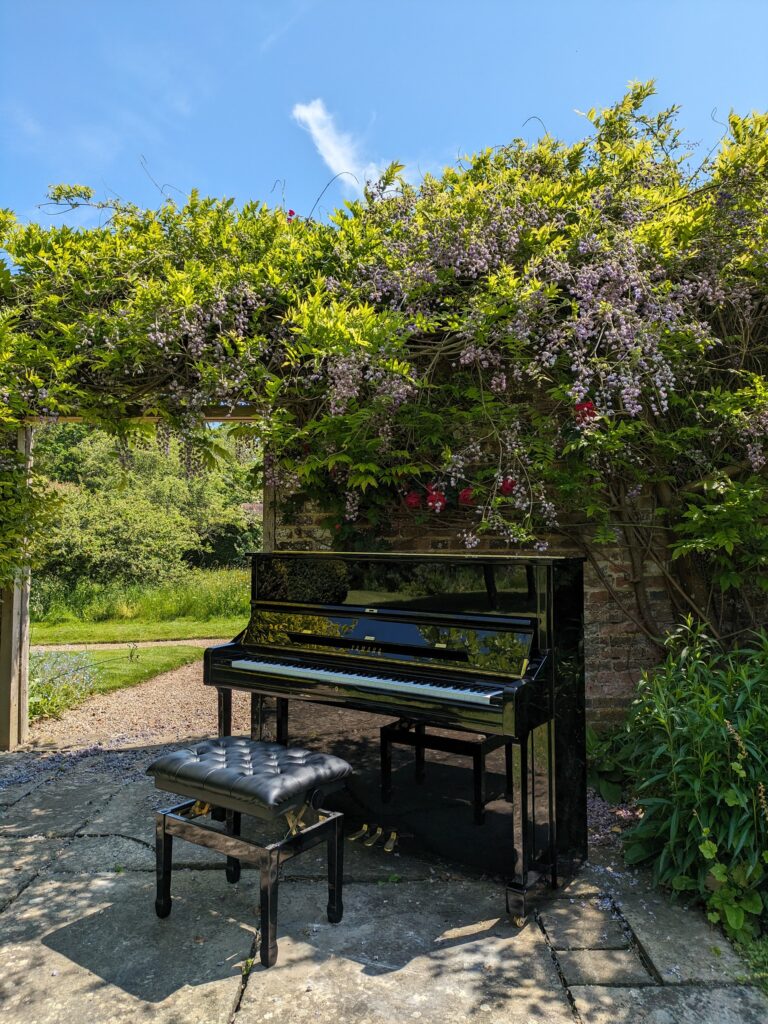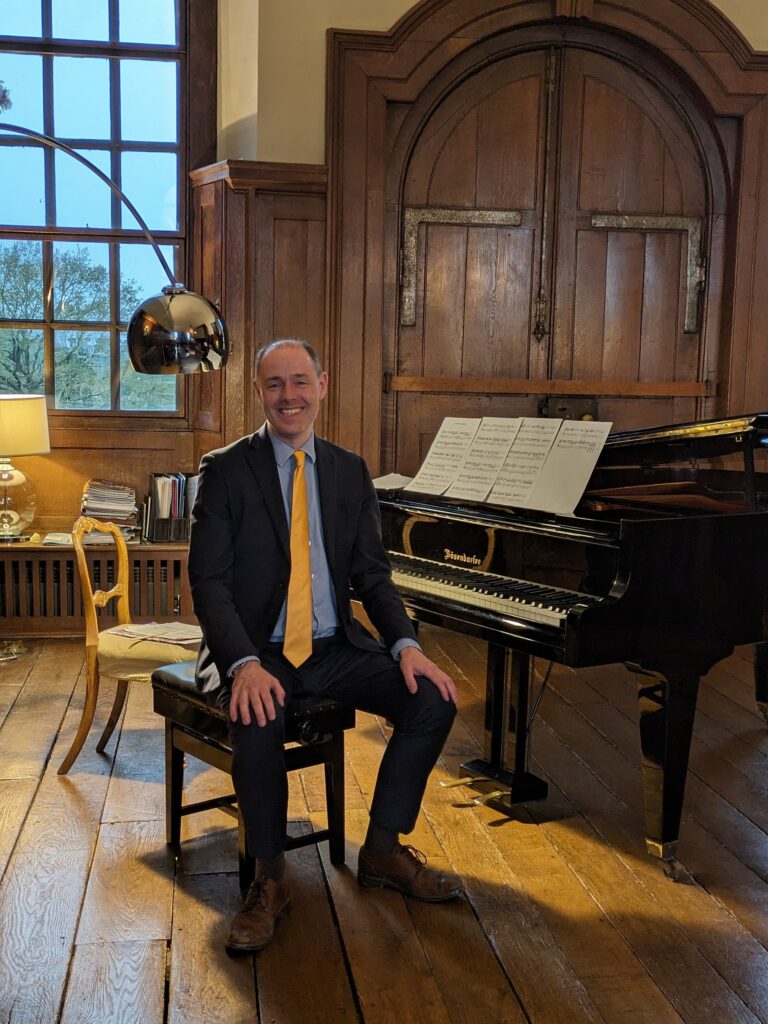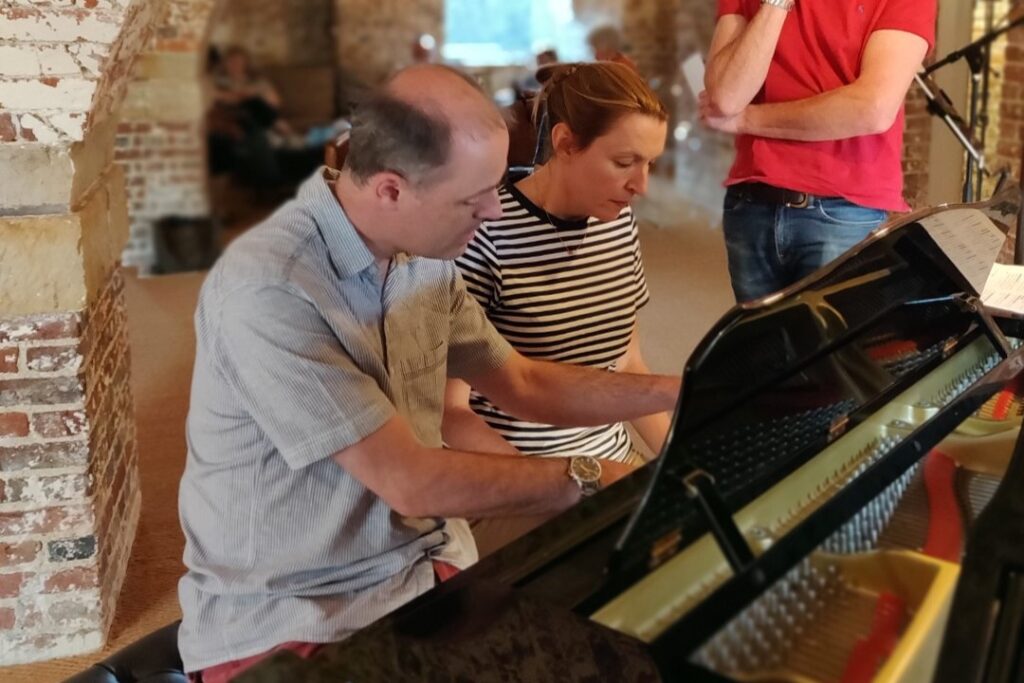We have a musical treat in store for all Finchcocks followers! When the BBC recently came to film Finchcocks, our Musical Director David Hall wrote Song of the Weald especially to mark the occasion. Now we are publishing it publicly for you all the enjoy.
The programme hasn’t aired yet, so we can’t give too much away, but it was a fascinating experience that showed Finchcocks in all its glory on a wonderful summer’s day! Emilija Ausraite played the piano beautifully for the recording. We’d love to let you have a go at it too, so David has written some practice tips below to help you to learn the Song of the Weald.
From David: Song of the Weald has a melody reminiscent of an English folksong, framed with a pianistic introduction and coda. Look out for nods to various composers – I have deliberately echoed Chopin, Brahms, Tchaikovsky and Debussy (some of the Finchcocks Favourites!) but I may well have pinched some ideas from others!
Play bars 1-4 with both hands together in parallel octaves. Imagine that the first phrase is a shepherd calling across the hills; the second phrase is his friend – another shepherd – answering. It’s important to work out the printed rhythms and to stick to them pretty closely, but both phrases should sound like improvised melody.
The RH chords in bars 5-8 need to be well-balanced with a shimmery tone. Use as much rubato as you dare leading up to the tenuto D in bar 8.
Bars 9-16 have a perfectly normal texture! The RH melody needs to be the strongest element with a beautiful legato touch. The LH needs to play warm bass notes, held with the pedal, and slightly lighter arpeggio figures. Bars 13 and 14 need some ebb and flow with extra dynamics that aren’t printed.
In bar 17, the RH begins to play a countermelody as well as a melody. The countermelody ought to be the loudest element here as it is new material. It requires some clever pedalling to maintain the legato with the RH thumb. The augmented chord in bar 22 is a bit cheeky (and is also a first hint of the move to B minor). It needs a tiny bit of tenuto to coax the ear of the listener, but not so much to draw attention and it certainly shouldn’t be played loudly.
The B section – starting in bar 25 is like a little Burgmüller study or some Tchaikovsky ballet music. A performer might choose to do the dynamics in both hands together or to keep the LH discreet with the dynamics in the RH only – both approaches work. The real challenge is the passage of parallel thirds, bars 33-37. The thirds need to be totally smooth. The upper note needs to be the louder of the two during the quaver passages; the lower note – A# – ought to be emphasized slightly on the dotted minims as it clarifies the B minor harmony.
The reprise of the A section has some fancy RH work reminiscent of Liszt’s Un Sospiro. In bar 41, use the thumb for the main melody and tiny flicks of the 5th finger for the upper notes. In bar 42, play the main melody note with the thumb, then jump up to play the upper octave with an extremely light thumb and the 5th finger for the super-high octave.
The coda begins in bar 57. To play this well, it is important to sing. Sing the bass descent so that each note leads to the next. Imagine how a cellist would enjoy the chromatic A# going on to the pedal A. Sing the melody and imagine how a violinist would use rubato to stretch up the E in bar 59. Don’t worry about bar 62 – it needs to sound gentle and relaxed! Work out how you are going to share the notes between the two hands. I would probably play four notes with the LH (starting on the D), then four notes with the RH, then four with the LH etc. Try to play as smoothly as possible and don’t worry about tempo or speed. It’s just a colourful splash. The final four bars are a warm sunset. Balance the chords really well. Just as with the main melody in bar 9, the top note needs to be the loudest, followed by the bass note (which must be warm rather than loud), followed by all the other notes i.e. your little fingers need to be strong and your thumbs controlled.
Have fun learning the piece! Remember that it is supposed to sound like a folksong, so the melody needs to ring out in a simple and direct way.
This is not David’s first publication! Both There’s more to playing the piano and newly released There’s even more to playing the more offer fantastically practical explanation and application of the nuts and bolts of music theory, with accompanying videos to demonstrate activities.
Enjoy Song of the Weald and we hope it conjurs happy memories of Finchcocks for you!





